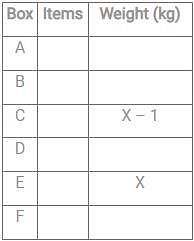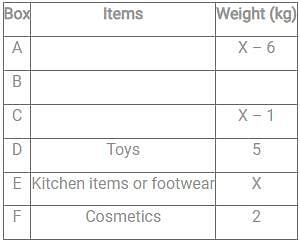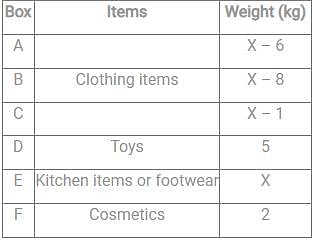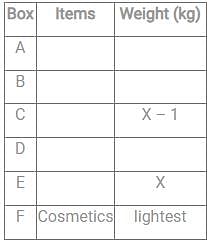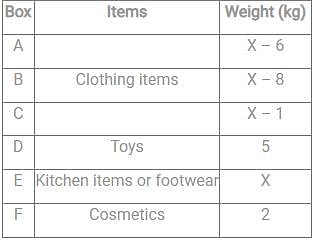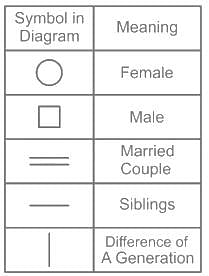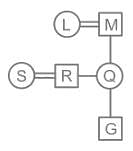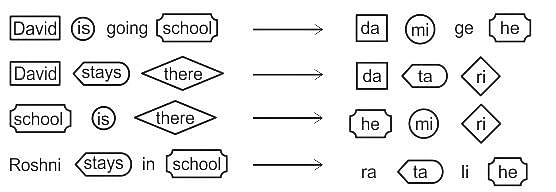ECGC PO Mock Test - 1 - Bank Exams MCQ
30 Questions MCQ Test Mock Test Series for ECGC PO 2024 - ECGC PO Mock Test - 1
Direction: In the given question below is given a statement followed by two conclusions numbered I and II. You have to assume everything in the statement to be true, then consider the two conclusions together and decide which of them logically follows the given statement and choose your answer according to that.
Statement: The distance of 900 km by road between Bombay and Jafra will be reduced to 280 km by sea. This will lead to a saving of Rs. 7.92 crores per annum on fuel.
Conclusions:
I. Transportation by sea is cheaper than that by road.
II. Fuel must be saved to the greatest extent
Statement: The distance of 900 km by road between Bombay and Jafra will be reduced to 280 km by sea. This will lead to a saving of Rs. 7.92 crores per annum on fuel.
Conclusions:
I. Transportation by sea is cheaper than that by road.
II. Fuel must be saved to the greatest extent
Recent statistics have shown that child labor has increased in urban areas. These children are exploited at a tender age and made to do odd jobs.
Q. Which of the following is a statement that can be inferred from the facts stated in the above statement?
| 1 Crore+ students have signed up on EduRev. Have you? Download the App |
Direction: Study the following information carefully and answer the questions given below.
Mansi has six boxes and she named the boxes as A, B, C, D, E and F so that she can identify what is in those boxes later. There are six categories of items namely, Books, Cosmetic, Kitchen, Clothing, Foot wears and Toys. Each box contains items from one of these categories according to their weight. No two boxes has same weight.
Box E is the heaviest box in weight and box C is 1 kg lighter than box E. All Cosmetic items are in box F and F is the lightest box in weight. Box D contains Toys and weighs 5 kg which is 3 kg heavier than box F. The heaviest box contains either Kitchen items or Footwear and is 6 kg heavier than box A. Box B contains Clothing items and weighs 2 kg less than box A. Box A neither contains Kitchen items nor Books and it’s weight is twice of the weight of box D.
Q. What is the weight of the heaviest box?
Mansi has six boxes and she named the boxes as A, B, C, D, E and F so that she can identify what is in those boxes later. There are six categories of items namely, Books, Cosmetic, Kitchen, Clothing, Foot wears and Toys. Each box contains items from one of these categories according to their weight. No two boxes has same weight.
Box E is the heaviest box in weight and box C is 1 kg lighter than box E. All Cosmetic items are in box F and F is the lightest box in weight. Box D contains Toys and weighs 5 kg which is 3 kg heavier than box F. The heaviest box contains either Kitchen items or Footwear and is 6 kg heavier than box A. Box B contains Clothing items and weighs 2 kg less than box A. Box A neither contains Kitchen items nor Books and it’s weight is twice of the weight of box D.
Direction: Study the following information carefully and answer the questions given below.
Mansi has six boxes and she named the boxes as A, B, C, D, E and F so that she can identify what is in those boxes later. There are six categories of items namely, Books, Cosmetic, Kitchen, Clothing, Foot wears and Toys. Each box contains items from one of these categories according to their weight. No two boxes has same weight.
Box E is the heaviest box in weight and box C is 1 kg lighter than box E. All Cosmetic items are in box F and F is the lightest box in weight. Box D contains Toys and weighs 5 kg which is 3 kg heavier than box F. The heaviest box contains either Kitchen items or Footwear and is 6 kg heavier than box A. Box B contains Clothing items and weighs 2 kg less than box A. Box A neither contains Kitchen items nor Books and it’s weight is twice of the weight of box D.
Q. If Mansi wants to unpack the box which contains her books, then which box should she open?
Direction: In the following question consists of a statement followed by two arguments I and II. You have to decide which of the arguments is a strong argument and which is a weak Argument.
Statement: Is the pen mightier than a sword?
Arguments :
I. Yes. Writers influence the thinking of the people.
II. No. With the help of physical force, one can conquer all.
Direction: Study the following information carefully and answer the given question.
In a family of six members L, M, Q, R, S and G there are three generations. S is wife of R. Q is sister of R. G is son of Q. M is father of Q and married to L.
Q. How is L related to R?
Directions: In this question, the relationship between different elements is shown in the statements. These statements are followed by two conclusions.
Statement: H < Y, Y ≥ R, R > W
Conclusions:
I. W < Y
II. R ≤ Y
“If a person is rich, he has a lot of influence.” What inference can you draw from the above statement?
Direction: Study the following information carefully and answer the given questions.
In a certain code language
‘da mi ge he’ means ‘David is going school’
‘da ta ri’ means ‘David stays there’
‘he mi ri’ means ‘school is there’
‘ra ta li he’ means ‘Roshni stays in school’
Q. How will ‘Roshni is going there’ be written in that code language?
What year was the National Mission for Clean Ganga (NMCG) established as a society?
Which Supreme Court ruling in 2024 related to the eligibility for Input Tax Credit (ITC) under GST?
Which city's Gharial Rehabilitation Center was approved for a breeding program for turtle and gharial conservation?
Who among the following was a co-recipient of the Nobel Prize in Physics 2024 for foundational work in artificial neural networks?
What was a significant technological focus for DRDO’s new program initiated in 2024?
What are the possible global effects of the Israel-Iran conflict noted in the article?
What was emphasized as necessary for the Namami Gange Programme to succeed?
Which of the following was NOT a focus of the approved Mahakumbh 2025 IEC activities?
Which Indian state's STPs were sanctioned in the latest NMCG meeting for setup?
What is the principal role of the National Council for Rejuvenation, Protection and Management of River Ganga?
Which DRDO technology is a medium-range surface-to-air missile system?
What is the percentage decline in freshwater ecosystems as reported in the Living Planet Report 2024?
What was the main driver of biodiversity loss according to the Living Planet Report 2024?
Which energy source is predicted to become the primary source of electricity by 2030 according to the World Energy Outlook 2024?
Which Supreme Court section of the Citizenship Act does Section 6A relate to, offering citizenship under specific conditions to certain immigrants from Bangladesh in Assam?
According to the Global Hunger Index 2024, what is the percentage of wasted children in India, marking the highest globally?
What is the primary implication of the Supreme Court's ruling on Section 6A of the Citizenship Act for immigrants in Assam?
What is the forecast for India's renewable energy growth according to the World Energy Outlook 2024?
Which Nobel Peace Prize recipient is known for advocacy towards nuclear disarmament?
What is the primary cause of rising temperatures in tropical forest KBAs according to recent studies?


